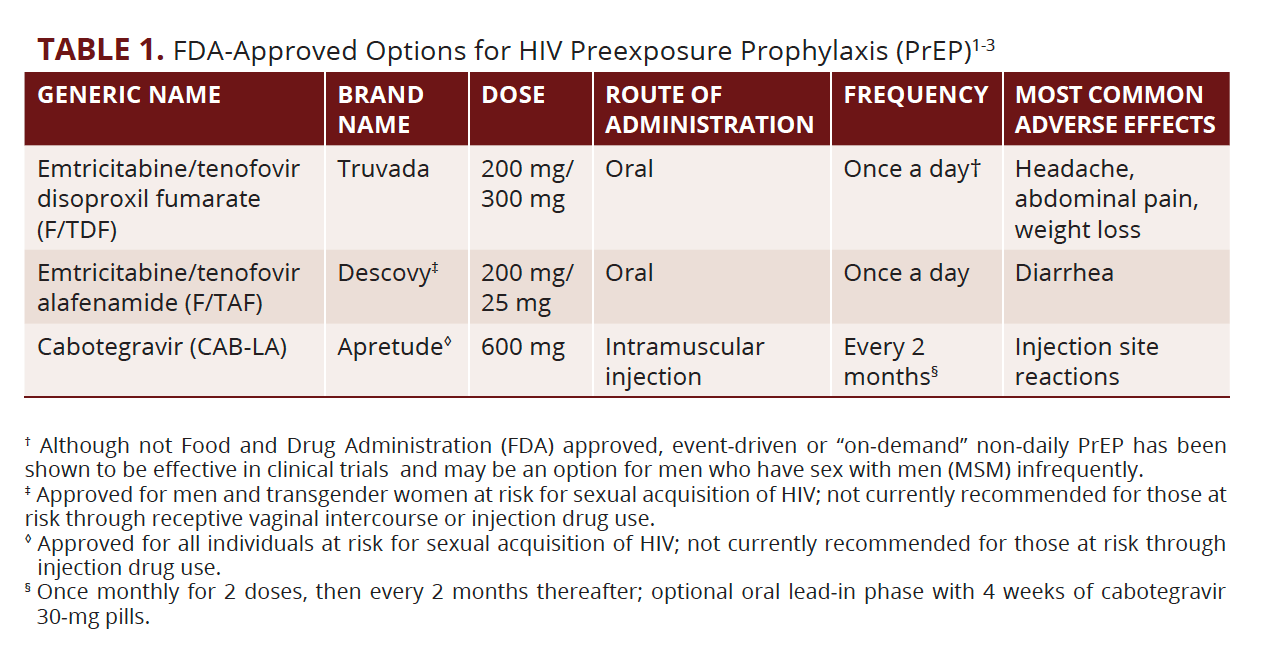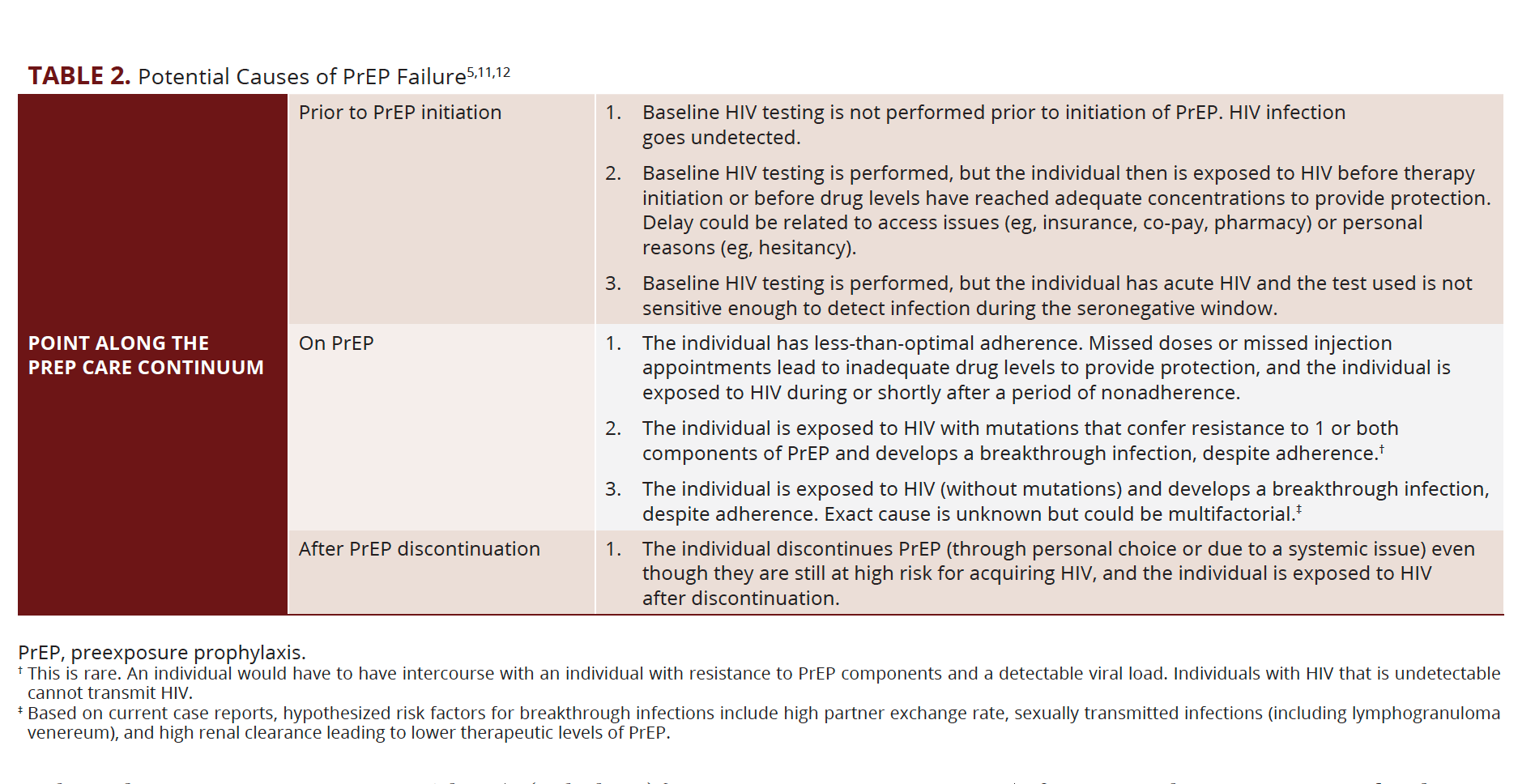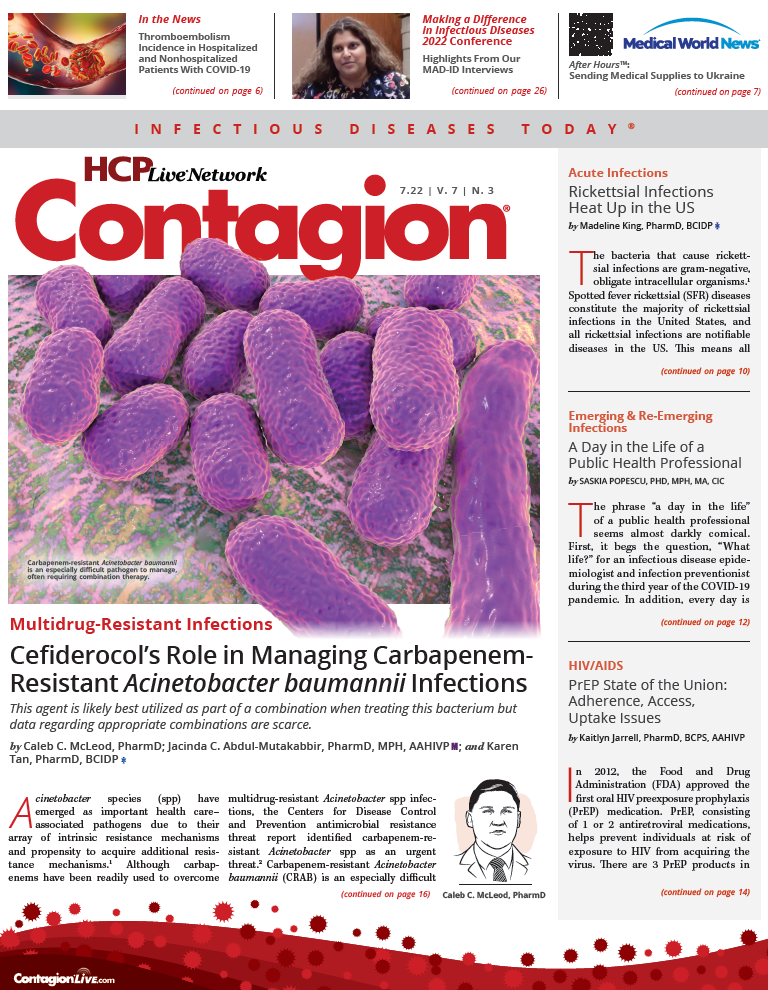PrEP State of the Union: Adherence, Access, Uptake Issues
Although this form of prophylaxis is highly protective, there are situations in which breakthrough infections occur.
In 2012, the Food and Drug Administration (FDA) approved the first oral HIV preexposure prophylaxis (PrEP) medication. PrEP, consisting of 1 or 2 antiretroviral medications, helps prevent individuals at risk of exposure to HIV from acquiring the virus. There are 3 PrEP products in the US: 2 oral pills and 1 long-acting injectable (TABLE 11-3).

Since PrEP became available, its uptake has steadily increased over the years. Unfortunately, disparities and underutilization remain. The Centers for Disease Control and Prevention (CDC) esti mates 1.2 million individuals would benefit from PrEP. However, in 2020, only 25% of eligible individuals received a prescription for it. Although this is a significant increase from previous years (eg, 3% received a prescription in 2015), there is room for growth, particularly within groups disproportionately affected by HIV.4
HOW EFFECTIVE IS PREP?
PrEP reduces the risk of acquiring HIV infection through intercourse by 99% when it is taken as prescribed.5 There are not as much data on those at risk for HIV acquisition through injection drug use. However, clinical trials have shown oral PrEP to reduce the risk of acquiring HIV by at least 74%. This figure is based on PrEP with tenofovir disoproxil fumarate (TDF) monotherapy with less-than-perfect adherence.5 Knowing this, it can be inferred that protection is likely greater using the 2-drug regimen (F/TDF) daily. Regardless, in order for PrEP to be effective, adherence is key.
Although injectable cabotegravir (CAB-LA) is newer to the scene (it was approved by the FDA in December 2021), data from the initial safety and efficacy trials, HPTN 083 (NCT02720094) and HPTN 084 (NCT03164564), have demonstrated its superiority compared with daily oral F/ TDF.6 These results likely can be attributed to eliminating the need for daily adherence: CAB-LA is administered every 2 months.
It is important to note that PrEP is not immediately effective. It takes time for the drug to accumulate in tissues to provide maximum protection. For receptive anal intercourse, oral PrEP is maximally protective after 7 days of daily use. For receptive vaginal intercourse and injection drug use, oral PrEP is maximally protective after 21 days of daily use. To date, there are no data showing how long it takes to achieve maximum protection for insertive anal and insertive vaginal intercourse. It also is unknown how long it takes for injectable PrEP to reach maximum protection.5
WHAT ABOUT THE OTHER 1%?
Most of the cases in which PrEP fails are due to less-than-optimal adherence, which results in inadequate drug levels that do not offer protection against HIV. These cases are different from breakthrough infections or true PrEP failures. Breakthrough infections are rare but they still are possible. As more individuals are prescribed oral PrEP, clinicians are slowly starting to see more individuals with optimal adherence who still contract HIV while on PrEP. So far, there have been fewer than 20 documented breakthrough infections despite more than 2 million PrEP initiations worldwide.7-9
Twelve case reports have been published describing cases of seroconversion while on oral PrEP despite adherence confirmed by detectable drug levels. Among these cases, 9 had HIV with mutations to 1 or both components of oral PrEP with or without additional mutations. Three of the 12 cases had no HIV resistance. Of the 12, 9 were receiving PrEP consisting of F/ TDF (8 daily, 1 on demand). The remaining 3 were receiving daily TDF.8-10
The initial trial for CAB-LA included both cisgender men who have sex with men and transgender women who have sex with men. During the trial, there were 7 breakthrough infections among participants who received their injections on time. In 2 of the 7 cases, drug levels unexpectedly decreased after the first injection.6 It may be that it takes longer for drug levels to reach adequate concentrations to provide protection. Despite these breakthrough infections, CAB-LA was shown to be highly effective, with a 66% reduction in incident HIV infections in study participants who received CAB-LA compared with F/TDF.6 A trial evaluating CAB-LA in women is ongoing, but there have been no breakthrough infections to date.
WHY DOES PREP FAIL?
There is no consensus definition for PrEP failure. Some have defined PrEP failure as any HIV infection that occurs at any point along the PrEP continuum of care. 11 These infections can occur due to several reasons (TABLE 25,11,12).

WHAT HAPPENS WHEN PREP FAILS?
When PrEP fails, there may be a delay in detection of HIV infection due to prolonged time to seroconversion. This delay is perhaps due to partial suppression of the virus by the antiretroviral components of PrEP. This is why quarterly HIV testing is essential for ongoing PrEP use.4 Further, any ambiguous HIV test results must be interpreted cautiously. Repeat testing with combination antigen/ antibody tests along with quantitative nucleic acid testing may be indicated, regardless of reported adherence.4
Although acquiring HIV while adherent to PrEP is uncommon, it is possible. Continuing PrEP while unknowingly having HIV can lead to antiretroviral drug resistance.13 Potential mutations that can occur with ongoing use of oral PrEP include M184V/I and K65R. M184V/I confers resistance to emtricitabine and lamivudine. It can arise in a relatively short period of time (2-3 weeks) in an individual taking oral PrEP that fails to suppress HIV. Fortunately, in clinical practice this may not be an issue because the M184V mutation reduces viral fitness and increases sensitivity to other antiretrovirals, including tenofovir. A K65R mutation is more rare and perhaps more serious; it confers at least some degree of resistance to all agents within the nucleoside reverse transcriptase inhibitor class, which are frequently used as backbones of HIV regimens.14 In the initial trial for CAB-LA, there were 5 cases that developed integrase strand transfer inhibitor (INSTI) resistance. One was a baseline infection and the remaining 4 were incident infections that occurred while the patient was receiving the long-acting injectable. None occurred after the last injection was given (tail phase).6 Major resistance mutations seen were Q148K/R and R263K, all of which confer some degree of resistance to the entire INSTI class. At this time, the benefit of PrEP greatly outweighs the small yet potential risk for development of drug resistance.4,13 However, strategies to prevent INSTI resistance with CAB-LA are needed.6
Fortunately, when and if PrEP fails, we have excellent options to treat most cases of HIV. Resistance due to PrEP use is not typically an issue, although it may be more problematic in resource-limited settings. Currently recommended first-line regimens for the treatment of HIV infection have high barriers to resistance and few adverse effects.15 Individuals who receive a diagnosis of HIV should have a confirmatory test and baseline labs. They should immediately be started on a guideline-recommended HIV treatment regimen and referred to an experienced provider for comprehensive medical management. Additionally, they should receive prompt education and counseling regarding their HIV status and how HIV is transmitted. Finally, they should be connected with their local health department to identify partners who may have recently been exposed through intercourse so that they may receive appropriate care.4,15
(PREP)PING FOR SUCCESS
As the US Department of Health and Human Services works toward ending the HIV epidemic, PrEP provision must continue to expand. Although substantial growth has occurred over the past few years, there continue to be disparities among racial groups, ethnic groups, age groups, geographic areas, and even by sex. According to the CDC, Black individuals receive a diagnosis of HIV at a rate 8 times higher than in White individuals. For Hispanic/Latino individuals, the rate is 4 times higher than among White individuals. Despite this, data show that only 9% of Black/African American individuals and 16% of Hispanic/Latino individuals who would benefit from PrEP have received a prescription.4 In general, people aged 16 to 24 years are the least likely to be using PrEP, with only 16% of eligible individuals receiving a prescription. Although cisgender women represented 19% of new HIV diagnoses, women are prescribed PrEP at a rate 3 times lower than men.4 In addition to addressing these disparities, comprehensive risk-reduction programs and interventions to prevent systemic barriers to receiving PrEP will need to be in place everywhere to help prevent failures along the PrEP continuum of care.
References
1. Emtricitabine and tenofovir disoproxil fumarate. Lexi-Drugs. Updated June 9, 2022. Accessed June 9, 2022. http://online.lexi.com/
2. Emtricitabine and tenofovir alafenamide. Lexi-Drugs. Updated April 19, 2022. Accessed June 9, 2022. http://online.lexi.com/
3. Cabotegravir. Lexi-Drugs. Updated May 11, 2022. Accessed June 9, 2022. http://online.lexi.com/
4. PrEP for HIV Prevention in the U.S. CDC. Accessed June 9, 2022. https://www.cdc.gov/nchhstp/newsroom/fact-sheets/hiv/PrEP-for-hiv-prevention-in-the-US-factsheet.html
5.CDC. PrEP for HIV prevention in the U.S. – fact sheet. Updated November 23, 2021. Accessed June 9, 2022. https://www.cdc.gov/nchhstp/newsroom/fact-sheets/hiv/PrEP-for-hiv-prevention-in-the-US-factsheet.html
6.Landovitz RJ, Donnell D, Clement ME, et al; HPTN 083 Study Team. Cabotegravir for HIV prevention in cisgender men and transgender women. N Engl J Med. 2021;385(7):595-608. doi:10.1056/nejmoa2101016
7. Carstens A. PrEP failures (breakthrough infections). NAM. May 2022. Accessed June 9, 2022. https://www.aidsmap.com/about-hiv/prep-failures-breakthrough-infections
8. Track Global PrEP Use. AVAC. Updated March 2022. Accessed June 9, 2022. valid.https://www.prepwatch.org/in-practice/global-prep-tracker/
9. WHO. HIV Drug Resistance Report 2021. November 2021. Accessed June 9, 2022. https://www.who.int/publications/i/item/9789240038608
10. To KW, Lee SS. A review of reported cases of HIV pre‐exposure prophylaxis failure with resultant breakthrough HIV infections. HIV Med. 2021;22(2):75-82. doi:10.1111/hiv.12989
11. Lee SS, Anderson PL, Kwan TH, et al. Failure of pre-exposure prophylaxis with daily tenofovir/emtricitabine and the scenario of delayed HIV seroconversion. Int J Infect Dis. 2020;94:41-43. doi:10.1016/j.ijid.2020.03.014
12. Hampel B, Viehweger M, Hijazi L, et al. Failure of daily PrEP with low peak levels of TDF/FTC with identification of the 184I mutation. Accessed June 9, 2022. https://mannschaft.com/bimber/wp-content/uploads/2019/11/20190830_PrEPFailure_EACS.pdf
13. Saloman L. How does PrEP affect seroconversion after HIV is acquired? Contagion®Live. July 27, 2017. Accessed June 9, 2022. https://www.contagionlive.com/view/how-does-prep-affect-seroconversion-after-hiv-is-acquired
14. Wensing AM, Calvez V, Ceccherini-Silberstein F, et al. 2019 update of the drug resistance mutations in HIV-1. Top Antivir Med. 2019;27(3):111-121.
15. Guidelines for the use of antiretroviral agents in adults and adolescents with HIV. Department of Health and Human Services. Accessed June 9, 2022. https://clinicalinfo.hiv.gov/en/guidelines/hiv-clinical-guidelines-adult-and-adolescent-arv/whats-new-guidelines

